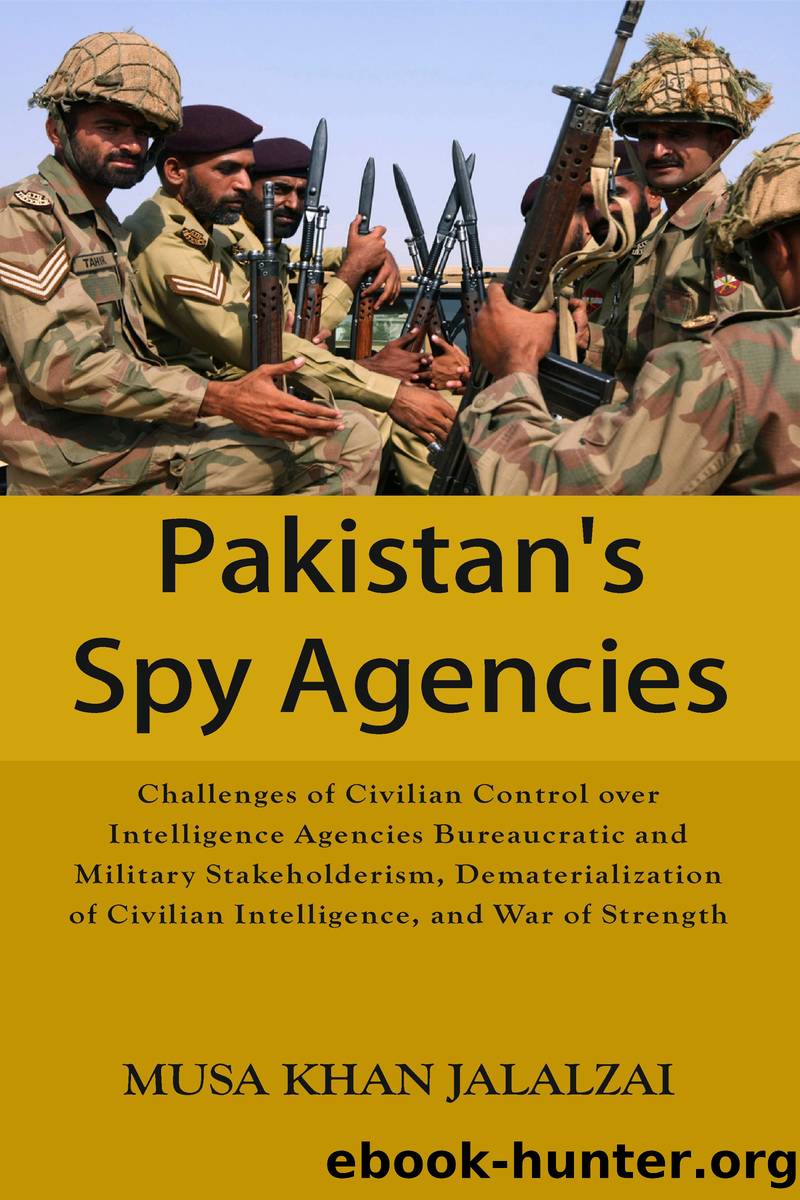Pakistans Spy Agencies by Musa Khan Jalalzai

Author:Musa Khan Jalalzai
Language: eng
Format: epub
Publisher: VIJ Books (India) PVT Ltd
Published: 2020-06-05T16:00:00+00:00
Chapter 7
Directorate S: The C.I.A. and America’s
Secret Wars in Afghanistan and Pakistan
Barbara Elias
In mesmerizing detail, Steve Coll’s Directorate-S documents the tragic policies of the US war in Afghanistan. It is a slow, heart-wrenching history of strategically compromised half-measures and uncoordinated bureaucratic practices, in which US, Pakistani, and Afghan allies have cooperated with and conspired against one another, over time enabling the Taliban to reclaim political and geographic space in Afghanistan. A sequel to Coll’s 2005 Pulitzer-winning volume Ghost Wars: The Secret History of the CIA, Afghanistan, and Bin Laden, from the Soviet Invasion to September 10, 2001 (2004) documenting the Soviet intervention in Afghanistan and the rise of the Taliban until 2001, Directorate S ambitiously and impressively provides a post-September 11 “history of how the C.I.A., ISI [Pakistan’s Inter-Services Intelligence], and Afghan intelligence agencies influenced the rise of a new war in Afghanistan after the fall of the Taliban, and how that war fostered a revival of Al Qaeda, allied terrorist networks, and, eventually, branches of the Islamic State” (p. 7). The book is named after Directorate S, the vexingly effective wing of the ISI that secretively and steadfastly assists the Taliban insurgency against US forces.
Dean of Columbia University’s School of Journalism, Coll draws on over five hundred interviews and hundreds of primary source documents to provide an outstanding narrative of a staggeringly complex conflict. The book combines such details as verbatim transcripts of tapped phone conversations between ISI officials with sweeping synopses on the cumulative effects of Pakistani, Afghan, and American policies. For example, in a section discussing US resistance to an Afghan request for expanded support for its intelligence agencies to help Kabul monitor Pakistani support of insurgents, Coll comments that this is a prime example of the American approach to Afghanistan, “deliberate minimalism, followed by tentative engagement, followed by massive investments only when it was very late to make a difference” (p. 192). Unlike the war itself, the book is superbly organized and beautifully composed. In a chapter examining the early years of American intervention, titled “Catastrophic Success,” Coll writes, “Thirty years of war—and now, after Operation Enduring Freedom, thousands of additional bombs dropped on the country—had left Afghanistan prostrate.... The country’s only real equities were international goodwill and some collective memory of a multiethnic country that had once been peaceful” (p. 111).
As a veteran specialist on Af-Pak issues, Coll readily complicates overly simplistic narratives. For instance, while providing ample evidence documenting the disastrous consequences for Islamabad’s duplicity supporting and undermining US counterinsurgency efforts, Directorate S also contextualizes ISI motivations to support Afghan insurgents. Aside from explaining that the Afghan Taliban was a way for Pakistan to hedge its bets against Indian influence in Afghanistan, Coll also documents how the more the ISI helped Washington by isolating the Taliban and other non-state entities, the more Islamabad risked being targeted by those groups. According to Coll, Pakistani intelligence was likely compelled to continue to support extremists, “to prove to its own restive clients that it was not going soft, and that it should not be considered the enemy.
Download
This site does not store any files on its server. We only index and link to content provided by other sites. Please contact the content providers to delete copyright contents if any and email us, we'll remove relevant links or contents immediately.
| Elections & Political Process | Ideologies & Doctrines |
| International & World Politics | Political Science |
| Public Affairs & Policy | Specific Topics |
| United States |
The Secret History by Donna Tartt(16617)
The Social Justice Warrior Handbook by Lisa De Pasquale(11489)
Thirteen Reasons Why by Jay Asher(7785)
This Is How You Lose Her by Junot Diaz(5764)
Weapons of Math Destruction by Cathy O'Neil(5034)
Zero to One by Peter Thiel(4823)
The Myth of the Strong Leader by Archie Brown(4789)
Promise Me, Dad by Joe Biden(4444)
Stone's Rules by Roger Stone(4415)
Beartown by Fredrik Backman(4411)
How Democracies Die by Steven Levitsky & Daniel Ziblatt(4396)
The Fire Next Time by James Baldwin(4340)
100 Deadly Skills by Clint Emerson(4075)
A Higher Loyalty: Truth, Lies, and Leadership by James Comey(4031)
Rise and Kill First by Ronen Bergman(4012)
The David Icke Guide to the Global Conspiracy (and how to end it) by David Icke(3880)
The Farm by Tom Rob Smith(3871)
Secrecy World by Jake Bernstein(3782)
The Doomsday Machine by Daniel Ellsberg(3730)
